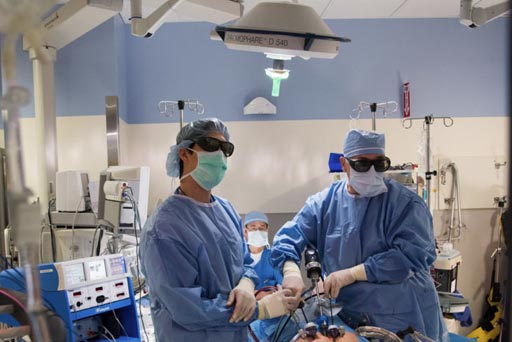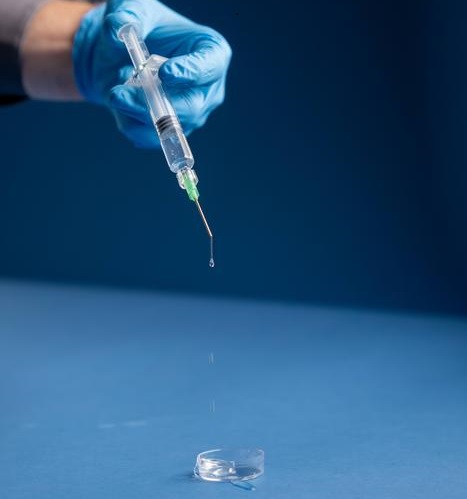Surgery Unnecessary for Early-Stage Prostate Cancer
|
By HospiMedica International staff writers Posted on 27 Jul 2017 |

Image: Professor Andriole (R) performing surgery on a patient with prostate cancer (Photo courtesy of WUSTL).
Results of a 20-year follow-up study among men with localized prostate cancer suggest that surgery is not associated with significantly lower all-cause or prostate-cancer mortality than observation.
Researchers at the Minneapolis Veterans Administration (VA) Health Care System (MN, USA), Washington University School of Medicine (WUSTL; St. Louis, MO, USA), and other institutions reported the most recent results of the prostate cancer intervention versus observation trial (PIVOT), which randomly assigned 731 men with localized prostate cancer to radical prostatectomy or observation from November 1994 to January 2002. Follow-up was extended through August 2014 for all-cause mortality and prostate-cancer mortality.
The results showed that during 19.5 years of follow-up, death attributed to prostate cancer or treatment occurred in 27 men (7.4%) assigned to surgery and in 42 men (11.4%) assigned to observation. Surgery was associated with lower all-cause mortality among men with intermediate-risk disease, but not among those with low-risk or high-risk disease. Treatment for disease progression was less frequent with surgery than with observation, and was primarily for asymptomatic, local, or prostate-specific antigen (PSA) progression. Urinary incontinence, erectile, and sexual dysfunction were each greater with surgery than with observation. The study was published on July 13, 2017, in the New England Journal of Medicine (NEJM).
“About 70% of patients newly diagnosed with prostate cancer cases are in the early stages, meaning the cancer is confined to the prostate gland, and they have nonaggressive tumors. As such, these patients have an excellent prognosis without surgery,” said study co-author Professor Gerald Andriole, MD, director of the WUSTL division of urologic surgery. “We hope the findings will steer doctors away from recommending surgery or radiation to their patients with nonaggressive early-stage prostate cancer and patients away from thinking its necessary.”
“However, the data show that surgery may have a mortality benefit in some men, particularly those with a long life expectancy and intermediate-risk prostate cancer. It would be a disservice to dismiss surgery as a viable option for patients with intermediate-risk prostate cancer,” concluded Professor Andriole. “For these patients, and for some men with high-risk prostate cancer, surgery is often beneficial, as are other treatments such as radiation.”
Observational strategies include active surveillance (AS), which involves close follow-up after diagnosis, typically with serial PSA testing, digital rectal exam, and prostate biopsies; and watchful waiting (WW), which refers to a strategy of observing patients without monitoring and providing palliative care when prostate cancer becomes symptomatic. AS is recommended for the 30% of men who will eventually require treatment for prostate cancer, while WW is historically reserved for men with less than 10 years' life expectancy or major comorbidities, and who are not expected to die of prostate cancer.
Related Links:
Minneapolis Veterans Administration
Washington University School of Medicine
Researchers at the Minneapolis Veterans Administration (VA) Health Care System (MN, USA), Washington University School of Medicine (WUSTL; St. Louis, MO, USA), and other institutions reported the most recent results of the prostate cancer intervention versus observation trial (PIVOT), which randomly assigned 731 men with localized prostate cancer to radical prostatectomy or observation from November 1994 to January 2002. Follow-up was extended through August 2014 for all-cause mortality and prostate-cancer mortality.
The results showed that during 19.5 years of follow-up, death attributed to prostate cancer or treatment occurred in 27 men (7.4%) assigned to surgery and in 42 men (11.4%) assigned to observation. Surgery was associated with lower all-cause mortality among men with intermediate-risk disease, but not among those with low-risk or high-risk disease. Treatment for disease progression was less frequent with surgery than with observation, and was primarily for asymptomatic, local, or prostate-specific antigen (PSA) progression. Urinary incontinence, erectile, and sexual dysfunction were each greater with surgery than with observation. The study was published on July 13, 2017, in the New England Journal of Medicine (NEJM).
“About 70% of patients newly diagnosed with prostate cancer cases are in the early stages, meaning the cancer is confined to the prostate gland, and they have nonaggressive tumors. As such, these patients have an excellent prognosis without surgery,” said study co-author Professor Gerald Andriole, MD, director of the WUSTL division of urologic surgery. “We hope the findings will steer doctors away from recommending surgery or radiation to their patients with nonaggressive early-stage prostate cancer and patients away from thinking its necessary.”
“However, the data show that surgery may have a mortality benefit in some men, particularly those with a long life expectancy and intermediate-risk prostate cancer. It would be a disservice to dismiss surgery as a viable option for patients with intermediate-risk prostate cancer,” concluded Professor Andriole. “For these patients, and for some men with high-risk prostate cancer, surgery is often beneficial, as are other treatments such as radiation.”
Observational strategies include active surveillance (AS), which involves close follow-up after diagnosis, typically with serial PSA testing, digital rectal exam, and prostate biopsies; and watchful waiting (WW), which refers to a strategy of observing patients without monitoring and providing palliative care when prostate cancer becomes symptomatic. AS is recommended for the 30% of men who will eventually require treatment for prostate cancer, while WW is historically reserved for men with less than 10 years' life expectancy or major comorbidities, and who are not expected to die of prostate cancer.
Related Links:
Minneapolis Veterans Administration
Washington University School of Medicine
Latest Surgical Techniques News
- Traditional Open Surgery for Lymph Node Removal Remains Gold Standard for Testicular Cancer
- 3D-Printed Porous Tantalum an Emerging Material for New Generation of Orthopedic Implants
- Flexible and Reusable Medical-Grade Plastic Device Aids Robot-Assisted Heart Surgery
- Robots to Play Larger Role in Surgery Due to Recent AI Developments
- Microscopic Wearables Snugly Wrap Around Neurons to Probe Brain’s Subcellular Regions
- Batteryless, Wireless Stent Sensor Warns of Blockages in Bile Duct
- Microgrippers For Miniature Biopsies to Create New Cancer Diagnostic Screening Paradigm
- Miniature Soft Lithium-Ion Battery Could Be Used as Defibrillator During Surgery
- TAVI Procedure Supported by Radial Artery Access Reduces Bleeding Complications
- Portable Surgical Robot Seamlessly Integrates into Any OR for Performing Cholecystectomy Procedures
- New Thoracic Surgery Risk Calculators Support Preoperative Decision-Making
- Surgical Platform with Miniature Humanoid-Shaped Robotic Arms Provides Human Level Dexterity
- Precision Surgical Technique Enables Lymph Node Detection and Removal in Endometrial Cancer
- Glowing Approach Helps Surgeons Assess Neural Blood Flow in Chronic Nerve Compression Neuropathy
- Predictive Model Identifies Best Patients for Minimally Invasive Epilepsy Surgery
- Light-Driven Micro-Robot Designed to Swim Autonomously in Viscous Liquids Could Be Used for Unblocking Blood Vessels
Channels
Critical Care
view channel‘Radar Stethoscope’ Paves Way for Contactless Medical Monitoring
A recent breakthrough in health monitoring utilizes radar technology to accurately 'listen' to patients' heart sounds, potentially paving the way for a new era of contactless medical monitoring devices.... Read more
Database Analysis Helps Identify “Sweet Spot” for Safe Surgery after Heart Attack
The 2014 perioperative guidelines from the American College of Cardiology and the American Heart Association recommend waiting 60 days after a heart attack before proceeding with elective noncardiac surgery.... Read morePatient Care
view channel
Portable Biosensor Platform to Reduce Hospital-Acquired Infections
Approximately 4 million patients in the European Union acquire healthcare-associated infections (HAIs) or nosocomial infections each year, with around 37,000 deaths directly resulting from these infections,... Read moreFirst-Of-Its-Kind Portable Germicidal Light Technology Disinfects High-Touch Clinical Surfaces in Seconds
Reducing healthcare-acquired infections (HAIs) remains a pressing issue within global healthcare systems. In the United States alone, 1.7 million patients contract HAIs annually, leading to approximately... Read more
Surgical Capacity Optimization Solution Helps Hospitals Boost OR Utilization
An innovative solution has the capability to transform surgical capacity utilization by targeting the root cause of surgical block time inefficiencies. Fujitsu Limited’s (Tokyo, Japan) Surgical Capacity... Read more
Game-Changing Innovation in Surgical Instrument Sterilization Significantly Improves OR Throughput
A groundbreaking innovation enables hospitals to significantly improve instrument processing time and throughput in operating rooms (ORs) and sterile processing departments. Turbett Surgical, Inc.... Read moreHealth IT
view channel
Machine Learning Model Improves Mortality Risk Prediction for Cardiac Surgery Patients
Machine learning algorithms have been deployed to create predictive models in various medical fields, with some demonstrating improved outcomes compared to their standard-of-care counterparts.... Read more
Strategic Collaboration to Develop and Integrate Generative AI into Healthcare
Top industry experts have underscored the immediate requirement for healthcare systems and hospitals to respond to severe cost and margin pressures. Close to half of U.S. hospitals ended 2022 in the red... Read more
AI-Enabled Operating Rooms Solution Helps Hospitals Maximize Utilization and Unlock Capacity
For healthcare organizations, optimizing operating room (OR) utilization during prime time hours is a complex challenge. Surgeons and clinics face difficulties in finding available slots for booking cases,... Read more
AI Predicts Pancreatic Cancer Three Years before Diagnosis from Patients’ Medical Records
Screening for common cancers like breast, cervix, and prostate cancer relies on relatively simple and highly effective techniques, such as mammograms, Pap smears, and blood tests. These methods have revolutionized... Read morePoint of Care
view channel
Handheld, Sound-Based Diagnostic System Delivers Bedside Blood Test Results in An Hour
Patients who go to a doctor for a blood test often have to contend with a needle and syringe, followed by a long wait—sometimes hours or even days—for lab results. Scientists have been working hard to... Read more
Smartphone-Enabled, Paper-Based Quantitative Diagnostic Platform Transforms POC Testing
Point-of-care diagnostics are crucial for public health, offering rapid, on-site testing that enables prompt diagnosis and treatment. This is especially valuable in remote or underserved regions where... Read moreBusiness
view channel
MEDICA 2024 to Highlight Hot Topics of MedTech Industry
Once again this year, everything at MEDICA (Düsseldorf, Germany) will revolve around the major trends and challenges in medical technology. The focus will be on four key topics that will have a lasting... Read more
Start-Ups To Once Again Play Starring Role at MEDICA 2024
The finalists in the 16th Healthcare Innovation World Cup and the 13th MEDICA START-UP COMPETITION have advanced from around 550 candidates based in 62 countries from Armenia to China and America to Rwanda.... Read more
Boston Scientific to Acquire AFib Ablation Company Cortex
Boston Scientific Corporation (Marlborough, MA, USA) has entered into a definitive agreement to acquire Cortex, Inc. (Santa Clara, CA, USA), the developer of a diagnostic mapping solution designed to identify... Read more















